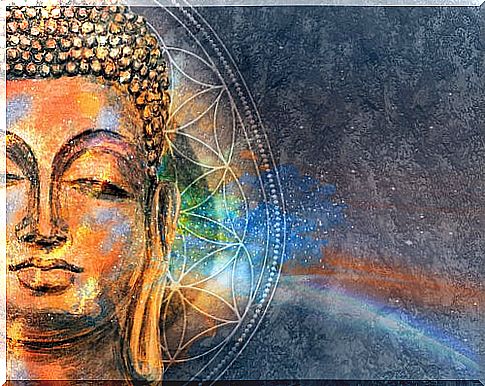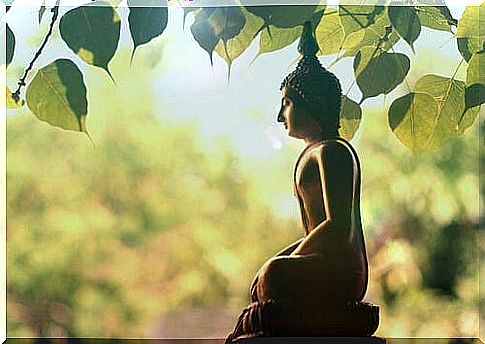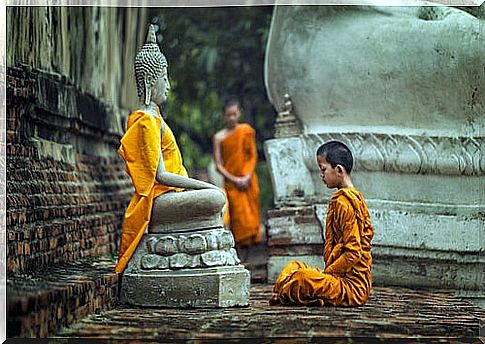The 4 Types Of Buddhism

Buddhism is not classified like other religions, according to hierarchies of power, whose peak is located in the figure of a person who houses the wisdom of sacred texts. However, we can find different schools, branches or types of Buddhism.
Buddhism is both a religion – though it doesn’t quite fit the formal definition of the term – and a philosophical doctrine. The set of traditions, beliefs and practices make up a behavior shared by between 200 and 1400 people called Buddhists. Like other classes of Eastern practices, the practice of some of its doctrines has become popular in the West.
What characterizes Buddhism?
Buddhism, originally from India between the 6th and 4th centuries BC. C., is the fourth religion in the world in terms of number of followers. Some attribute two main branches to it: Therevada (or School of the Elders) and Mahāyāna (Great Way), although these are greatly diversified and there is no consensus.

For Buddhism, the Buddhist scriptures, its sacred texts, are the object of study. The objective is to cultivate wisdom, practice meditation, renounce the material, favor kindness and compassion, among others. There are monastic variants of Buddhist practices, but most of those belonging to this religion practice it less intensively. Despite everything, the philosophical principles of Buddhism are shared by the entire community.
The understanding of Buddhism is holistic : the teachings of this practice interrelate and compose one another. In turn, it is emphasized that these teachings are but a guide to the Dharma (“things as they are” in Sanskrit).
Branches or types of Buddhism
According to the classification criteria, we can find different ways to practice Buddhism. According to the number of practitioners, the three main branches of Buddhism are mahāyāna, therevāda, and vajrayāna. However, when looking for another sort of classifications, Buddhism appears to us to be highly decentralized.
It is somewhat inaccurate to speak of “types of Buddhism”, since the variants of it coincide at some point in various aspects, such as the historical starting point of the doctrine. The different teachings approach and move away in a way that makes their classification difficult for us. Considering this fact, it is possible to organize the different beliefs artificially, according to affinities and dissimilarities.
1. Traditional Buddhism and modern Buddhism
The first classification that we can make has to do with the origin of the practice. While traditional or original Buddhism is a set of ancient beliefs, traditions and practices, there are also modern interpretations of that system.
2. Original Buddhism of Nikāya schools
According to this classification, there are 19 classes of Buddhism, 19 Nikāya schools. This is the name by which the early schools of Buddhism are designated. Of these 19, only Therevāda Buddhism has survived. This branch of Buddhism identifies as true sutras the contents of the Pāli Canon, a set of sacred texts.
In therevāda Buddhism, introspection takes center stage. Individual experience and critical reasoning oppose blind faith in this introspection, with the aim of liberating yourself and reaching nirvana.
Today therevāda Buddhism is practiced in Thailand, Laos, Cambodia, and Myanmar. One of its central aspects is the shanga, or monastic community. The monks own very little property and live in austere lodgings.
Their main activity is meditation, which they practice to empty the mind of the self and get closer to nirvana. Although the ideal is a fully monastic life, the laity also have their place in therevāda Buddhism. These play an important role, since they contribute to the sustenance of the monks in their search for an ascetic way of life; for example, they provide you with food in exchange for blessings and teachings.
3. Rama mahāyāna
If we look at the Mahāyāna branch of Buddhism, the classification of its types is different. As we have already seen, this is one of the three major branches of this set of beliefs. Unlike therevāda Buddhism, the teachings are more of a guide than a doctrine, aiming to unravel the truth, through criticism and reasoning, challenging the theories of the past. We could assimilate it to the scientific method. It also departs from Therevāda Buddhism in terms of accepting other kinds of sutras.
Among the types of Mahāyāna Buddhism is, for example, Zen Buddhism, known as the Chinese version of Buddhism.
Zen Buddhism appeals for meditation, the attainment of enlightenment, the value of experience above scripture, and the belief that human beings are one with the cosmos and share identity with everything in it. The intuitionism and irrationalism of Zen Buddhism have caught the attention of philosophers in the United States and Western Europe.
For the practitioners of this current, Zen affects all aspects of life: physical, intellectual and spiritual. Likewise, writing poetry and creating minimalist rock gardens are considered especially expressive activities. The best known Zen schools are the rinzai and the soto.

4. Vajrayāna Buddhism
Also called “Tibetan Buddhism”, it developed in the Himalayas and is the main religion of Bhutan and Mongolia. If we attend to this kind of Buddhism, we find four schools:
- Nyingma : this school is related to the purification of the body, speech and mind, relative to deities and promoter of the absolute truth.
- Kagyu : this school promoted the transcendence of conceptual elaboration, the simplification of phenomena and the possession of the path above meditation.
- Sakya : it is based on the Lamdré or “way of the fruit” teaching. The main Dharma system of this school is the “path with its result”
- Gelug : It is one of the main schools of Buddhism in Tibet, and the Dalai Lama belongs to it. She is sometimes included in Mahāyāna Buddhism for sharing certain sutras with him.
Divided into more or less types, Buddhism has inspired one of the main currents of thought that survive in a world that goes faster and faster, that looks more outward and less inward.









